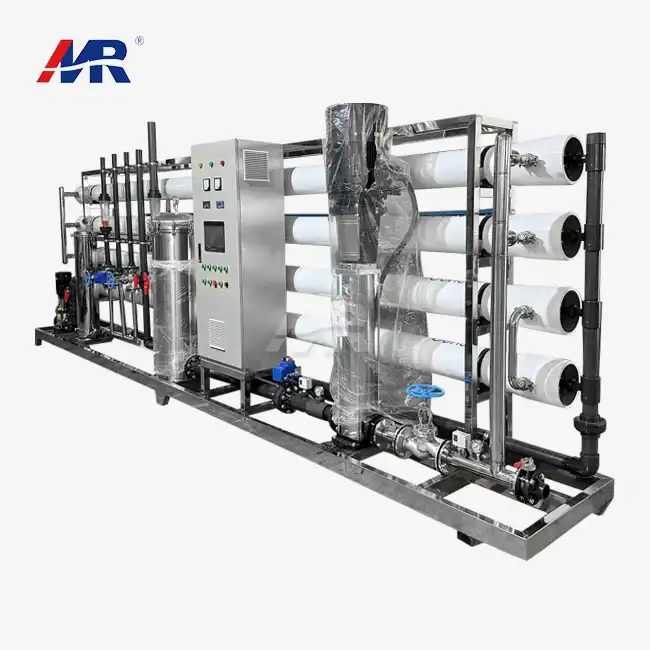How SWRO plants convert seawater to drinking water
Seawater Reverse Osmosis (SWRO) plants employ a multi-step process to transform seawater into potable water. This intricate procedure involves several key stages, each crucial for producing high-quality drinking water.
Intake and pre-treatment
The process begins with seawater intake, where large volumes of water are drawn from the ocean. This water then undergoes pre-treatment to remove larger particles and organisms. Screens and filters eliminate debris, while chemical treatments may be used to prevent biofouling of the membranes.
High-pressure pumping
After pre-treatment, the seawater is pressurized using high-pressure pumps. This step is essential as it provides the necessary force to overcome the natural osmotic pressure of seawater, enabling the reverse osmosis process to occur.
Reverse osmosis filtration
The heart of the SWRO process lies in the reverse osmosis system. Here, the pressurized seawater is forced through semi-permeable membranes. These membranes act as extremely fine filters, allowing water molecules to pass through while rejecting salt ions and other impurities.
Post-treatment and remineralization
The water emerging from the RO membranes is essentially pure H2O, lacking minerals necessary for taste and health. Therefore, it undergoes post-treatment, which often includes remineralization to add essential minerals back into the water. pH adjustment may also be performed to ensure the water is neither too acidic nor too alkaline.
Disinfection and storage
Finally, the treated water is disinfected to eliminate any remaining pathogens. Common methods include chlorination or UV treatment. The purified water is then stored in tanks, ready for distribution to consumers or industrial users.
Energy recovery devices in desalination RO systems
Energy recovery devices (ERDs) play a crucial role in modern desalination reverse osmosis plants, significantly enhancing their energy efficiency and economic viability. These innovative components recover and reuse the high-pressure energy from the concentrate stream, which would otherwise be wasted.
Types of energy recovery devices
Several types of ERDs are commonly used in RO desalination systems:
- Pressure Exchanger (PX) devices: These work on a direct energy transfer principle, exchanging pressure between the high-pressure concentrate and the incoming feedwater.
- Turbochargers: These devices convert the hydraulic energy of the concentrate into mechanical energy, which is then used to pressurize the feedwater.
- Hydraulic turbines: Similar to turbochargers, these convert hydraulic energy into mechanical energy, which can be used to drive pumps or generate electricity.
Benefits of energy recovery in RO desalination
The implementation of ERDs in reverse osmosis desalination offers several significant advantages:
- Reduced energy consumption: ERDs can recover up to 60% of the energy used in the RO process, dramatically lowering the overall energy requirements.
- Cost savings: By reducing energy consumption, ERDs contribute to substantial operational cost reductions.
- Improved system efficiency: ERDs enhance the overall efficiency of the RO system, allowing for higher water recovery rates.
- Environmental benefits: Lower energy consumption translates to reduced carbon emissions, making the desalination process more environmentally friendly.
Future developments in energy recovery
Ongoing research and development in ERD technology promise even greater efficiencies in the future. Innovations such as advanced materials for pressure exchangers and improved turbine designs are expected to further reduce energy consumption in desalination processes, making freshwater production from seawater increasingly sustainable and cost-effective.
Pretreatment for seawater reverse osmosis plants: Key steps
Effective pretreatment is crucial for the optimal performance and longevity of seawater reverse osmosis plants. This process involves several key steps designed to remove contaminants that could potentially damage or foul the RO membranes, ensuring the efficient operation of the BWRO plant.
Screening and chlorination
The initial stage of pretreatment typically involves coarse screening to remove large debris from the incoming seawater. This is often followed by chlorination to control biological growth in the system. However, it's important to note that chlorine must be removed before the water reaches the RO membranes, as it can damage them.
Coagulation and flocculation
Coagulation involves adding chemicals to the water to destabilize suspended particles. This is followed by flocculation, where gentle mixing encourages these destabilized particles to collide and form larger, more easily removable flocs.
Dissolved air flotation (DAF)
In some cases, particularly where the seawater contains high levels of algae or organic matter, dissolved air flotation may be employed. This process uses air bubbles to float contaminants to the surface, where they can be skimmed off.
Media filtration
Media filtration, often using sand or multi-media filters, is a crucial step in removing suspended solids from the water. These filters can effectively remove particles down to about 10-20 microns in size.
Cartridge filtration
As a final safeguard before the water enters the RO system, cartridge filters are used to remove any remaining fine particles. These filters typically have a pore size of 5 microns or less.
Chemical dosing
Various chemicals may be added during the pretreatment process:
- Antiscalants to prevent scale formation on the membranes
- pH adjusters to optimize the water chemistry for RO operation
- Sodium bisulfite to remove any residual chlorine
Importance of proper pretreatment
Effective pretreatment is essential for several reasons:
- Membrane protection: It prevents fouling and damage to the expensive RO membranes, extending their lifespan.
- Improved efficiency: Properly pretreated water allows the RO system to operate at optimal efficiency.
- Reduced operational costs: By preventing membrane fouling and damage, pretreatment helps reduce the frequency of membrane cleaning and replacement.
- Consistent water quality: Effective pretreatment ensures more consistent and higher quality product water from the RO system.
In conclusion, reverse osmosis equipment for seawater desalination represents a critical technology in addressing global water scarcity. From the intricate process of converting seawater to drinking water, to the energy-saving innovations in RO systems, and the crucial pretreatment steps, every aspect of these plants is designed for maximum efficiency and effectiveness. As we continue to face water challenges worldwide, the ongoing advancements in RO technology offer promising solutions for sustainable water management.
Are you looking for high-quality reverse osmosis equipment for your seawater desalination needs? Look no further than Guangdong Morui Environmental Technology Co., Ltd. We specialize in water treatment solutions, offering a comprehensive range of services including industrial wastewater treatment, domestic sewage treatment, seawater desalination, and drinking water manufacturing. Our state-of-the-art reverse osmosis plants are designed to meet the demanding water purification needs of various industries, from municipal water treatment to pharmaceutical manufacturing.
With our team of experienced engineers, in-house membrane production facility, and partnerships with leading brands in water treatment technology, we provide not just equipment, but complete solutions tailored to your specific requirements. Our one-stop installation and commissioning services, coupled with our comprehensive after-sales support, ensure that your reverse osmosis system operates at peak efficiency, delivering high-quality water consistently.
Whether you're a large corporation looking for industrial-scale water treatment solutions or a smaller enterprise seeking efficient and reliable desalination equipment, we have the expertise and resources to meet your needs. Don't let water scarcity limit your operations. Contact us today at benson@guangdongmorui.com to discover how our advanced reverse osmosis technology can solve your water challenges and support your business growth.
References
1. Voutchkov, N. (2018). Desalination Project Cost Estimating and Management. CRC Press.
2. Gude, V. G. (2020). Emerging Technologies for Sustainable Desalination Handbook. Butterworth-Heinemann.
3. Lattemann, S., & Höpner, T. (2008). Environmental impact and impact assessment of seawater desalination. Desalination, 220(1-3), 1-15.
4. Schorr, M. (2011). Desalination: Trends and Technologies. IntechOpen.
5. Fritzmann, C., Löwenberg, J., Wintgens, T., & Melin, T. (2007). State-of-the-art of reverse osmosis desalination. Desalination, 216(1-3), 1-76.
6. Greenlee, L. F., Lawler, D. F., Freeman, B. D., Marrot, B., & Moulin, P. (2009). Reverse osmosis desalination: Water sources, technology, and today's challenges. Water Research, 43(9), 2317-2348.

_1745823981883.webp)


